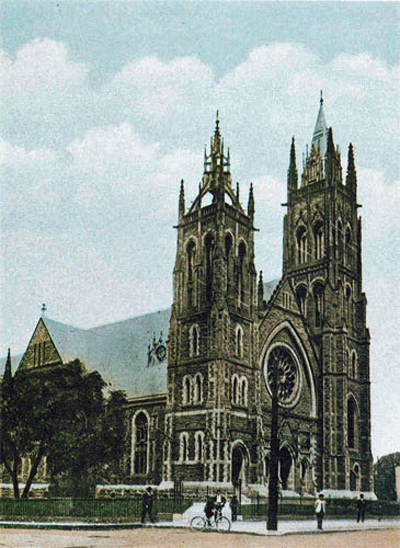St. James United Church National Historic Site of Canada
Montréal, Quebec

Postcard
© ANQ-Q, n.d.
Address :
463 Sainte-Catherine Street West, Montréal, Quebec
Recognition Statute:
Historic Sites and Monuments Act (R.S.C., 1985, c. H-4)
Designation Date:
1997-09-22
Dates:
-
1887 to 1888
(Construction)
Event, Person, Organization:
-
The Methodist Church of Canada
(Organization)
-
Alexander Francis Dunlop
(Architect)
Other Name(s):
-
St. James United Church
(Designation Name)
Research Report Number:
1996-034
Plaque(s)
Existing plaque: 463 Sainte-Catherine Street West, Montréal, Quebec
This former Methodist church is an excellent example of High Victorian Gothic Revival architecture, exhibiting rich polychromatic stonework on the exterior and intricate plasterwork on the interior ceiling. The attractive and well-preserved amphitheatre plan in the church proper reflects the central role of the preacher, while the adjoining Sunday school, now altered, underlines the importance of education. Built in 1887-1888 to designs by Alexander F. Dunlop, St. James represents Methodism's late phase, one of prosperity and broadened social commitment for many adherents.
Description of Historic Place
St. James United Church National Historic Site of Canada is located on St. Catherine Street West within a commercial district of downtown Montréal, Quebec. It is a large, late 19th-century stone church, built in the High Victorian Gothic Revival style distinguished by two massive towers on the primary façade that border a prominent rose window set above a triple portal entrance. Official recognition refers to the church on its legal lot at 463 St. Catherine Street West.
Heritage Value
St. James United Church was designated a national historic site of Canada in 1996 because: it is the best known example of a church in Canada combining a large, attractive and well-preserved amphitheatre plan with Victorian decoration in the nave and transept and a Sunday school influenced by the Akron plan in the chancel; its exterior is a fine example of a church in the high Victorian Gothic Revival style; and the church itself is closely associated with the late phase of Methodism, when the denomination espoused a moderate approach to religion and when many Methodists had become well-to-do members of society.
Built between 1887 and 1888 as a Methodist church, St. James United Church is representative of the late phase of Methodism, an evangelical protestant movement founded in the mid-18th-century. By the late 19th century, Methodist congregations included many prosperous and well-placed members of society. Late-19th-century Methodism had matured from an earlier focus on revival meetings and religious conversions towards an emphasis on moderation, gradualism and the central place of church institutions in the religious life of the individual. Central among these institutions was the Sunday school, as seen clearly in St. James United Church, which fostered the education and spiritual development of all ages
St. James United Church illustrates Methodist church designs from the late Victorian era in its large scale, central location, eclectic Gothic Revival exterior, amphitheatre-based interior plan and the inclusion of elaborate sunday school facilities. The large scale and elaborate design of the church reflects the social, political and economic importance of its members. The amphitheatre plan of the nave and transept maintained the central role of the preacher in Methodism. The sunday school facilities and their location in the chancel reflected the importance of education and spiritual development within the church. Inspired by the Akron plan, a mid-19th century innovation in sunday school design, the room featured a semi-circular plan and a moveable wall system that accommodated both small-group classroom study and large-scale assemblies.
St. James United Church reflects the High Victorian phase of Gothic Revival architecture, in its eclectic use of historical references and its inspiration from both French and Italian Gothic architecture. On the exterior, a high gable slate roof adorns the polychromatic façades. The ornate plaster decoration of the interior, in the form of moulded and carved arches and ribs, suspended from roof trusses and without supporting pillars, has a High Victorian Gothic flourish. The interior is illuminated with natural light through stained glass windows decorated with wooden tracery and Gothic motifs, such as quatrefoils, along the walls at the floor and gallery level.
Source: Historic Sites and Monuments Board of Canada, Minutes, February 1996.
Character-Defining Elements
Key elements which relate to the heritage value of the site include: its location on St. Catherine Street West within a commercial district of downtown Montréal, Quebec; its siting, set back from the street; its large scale and massing in the shape of a cruciform with apse and narthex; its stone construction and the polychromy of the exterior stonework created with a base of local, grey limestone, supporting walls of red Credit Valley sandstone, and olive-green sandstone trim from Chaleur Bay; surviving original exterior materials, including stone, stained-glass windows, and slate roofing; its High Victorian Gothic Revival style, evident in its exterior features such as the pointed arches, buttresses, label mouldings, and window tracery; elements inspired by French Gothic architecture, including a large rose window, two asymmetric towers of 43 metres and 61 metres in height, the triple portal, and the naturalistic frieze over the central entrance; elements inspired by Italian Gothic architecture, including the striped voussoirs over the doorways; elements contributing to its amphitheatre-like Akron interior plan, including the projecting gable roofed transepts, an extended chancel, containing evidence of the original sunday school, and evidence of the original amphitheatre; other exterior elements including the chancel, with buttresses dividing the three-storey elevation into bays, each capped by a metal gable; surviving original interior features at the north end of the sanctuary which typify Methodist churches of the period, including the communion rail, the pulpit platform, the pews for the choir and the organ; surviving original interior features and finishes in the nave and transept, including the plaster decoration including the ornate plaster ceiling, the sanctuary furnishings, woodwork, and wainscoting; the 1920s commercial building fronting St. Catherine Street.